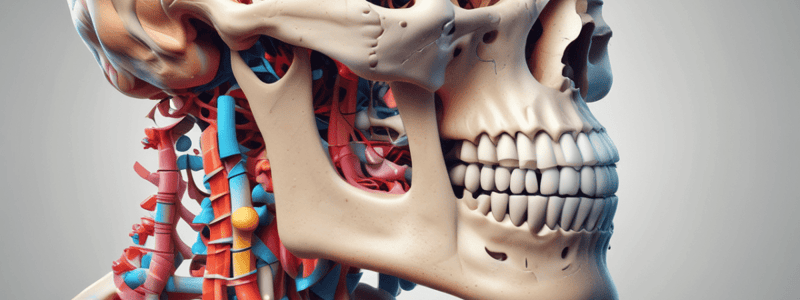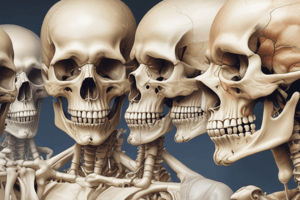Podcast
Questions and Answers
Where in the body do osteomas usually occur?
Where in the body do osteomas usually occur?
- Proximal tibia and humerus
- Facial bones (correct)
- Vertebral column
- Metaphysis of femur and tibia
What is the typical age range for osteoblastomas?
What is the typical age range for osteoblastomas?
- 10-20 (correct)
- 20-30
- 40-50
- 50-60
Which of the following is a benign bone-forming tumor?
Which of the following is a benign bone-forming tumor?
- Osteosarcoma
- Osteoma (correct)
- Ewing's sarcoma
- Chondrosarcoma
What is the malignant counterpart of osteosarcoma?
What is the malignant counterpart of osteosarcoma?
Which bone tumor type has a characteristic exophytic growth from the bone surface?
Which bone tumor type has a characteristic exophytic growth from the bone surface?
Where do osteoid osteomas mainly occur?
Where do osteoid osteomas mainly occur?
What is the typical age range at presentation for osteoid osteoma?
What is the typical age range at presentation for osteoid osteoma?
Which benign bone tumor shows a radiolucent zone surrounded by a halo of increased density on radiographs?
Which benign bone tumor shows a radiolucent zone surrounded by a halo of increased density on radiographs?
What is a characteristic feature of pain associated with an osteoid osteoma?
What is a characteristic feature of pain associated with an osteoid osteoma?
Which treatment option is NOT commonly used for osteoid osteoma?
Which treatment option is NOT commonly used for osteoid osteoma?
What is the M:F ratio for osteoid osteoma cases?
What is the M:F ratio for osteoid osteoma cases?
Which benign bone tumor has histologic and radiographic similarities to osteoid osteoma but typically occurs in a slightly older population?
Which benign bone tumor has histologic and radiographic similarities to osteoid osteoma but typically occurs in a slightly older population?
At what age range are osteomas typically found?
At what age range are osteomas typically found?
Which bone tumor is known for its exophytic growths attached to bone surfaces?
Which bone tumor is known for its exophytic growths attached to bone surfaces?
Where is Osteoid osteoma usually located within the bone?
Where is Osteoid osteoma usually located within the bone?
Which tumor form grows outward, lifting periosteum, and inward to the medullary cavity?
Which tumor form grows outward, lifting periosteum, and inward to the medullary cavity?
Flashcards are hidden until you start studying
Study Notes
Osteomas
- Most commonly found in the skull and facial bones.
- Typically diagnosed in patients over 30 years old.
Osteoblastomas
- Benign bone-forming tumor.
- Typically found in patients between 10-30 years old.
Benign Bone-Forming Tumors
- Osteosarcoma is a benign bone-forming tumor.
Malignant Counterpart of Osteosarcoma
- The malignant counterpart of osteosarcoma is osteosarcoma.
Exophytic Growth
- Osteomas have a characteristic exophytic growth from the bone surface.
Osteoid Osteomas
- Occur mainly in long bones.
- Typically diagnosed in patients between 10-30 years old.
- Show a radiolucent zone surrounded by a halo of increased density on radiographs.
- Pain is often worse at night and is relieved by aspirin.
- Treatment usually involves surgical excision.
- The M:F ratio is 2:1.
Benign Bone Tumor Similar to Osteoid Osteoma
- Osteoblastoma is a benign bone tumor with similar features to osteoid osteoma.
- Typically occurs in a slightly older population.
Age Range for Osteomas
- Osteomas are typically found in patients over 30 years old.
Exophytic Growths Attached to Bone Surfaces
- Osteomas are known for their exophytic growths attached to bone surfaces.
Location of Osteoid Osteoma Within Bone
- Osteoid osteomas are usually located in the cortex of long bones.
Form Growing Outward and Inward
- Osteoblastomas grow outward lifting the periosteum and inward to the medullary cavity.
Studying That Suits You
Use AI to generate personalized quizzes and flashcards to suit your learning preferences.




